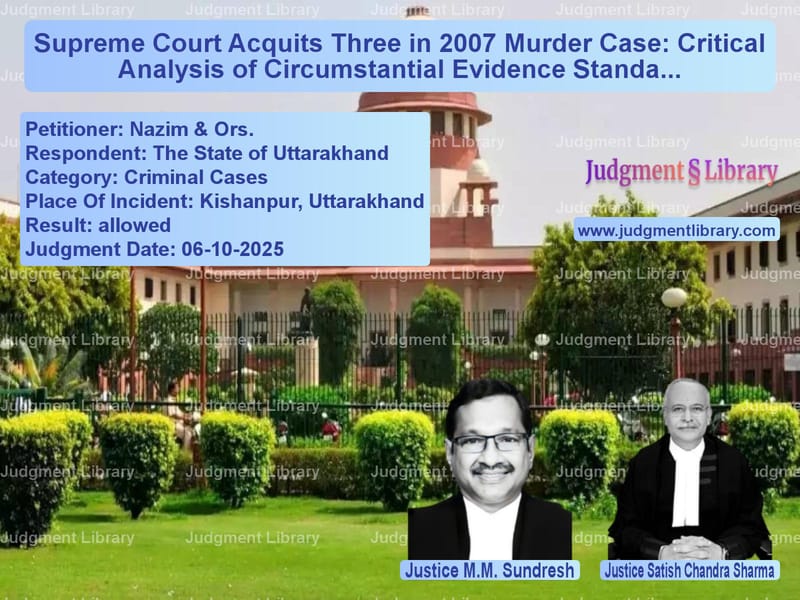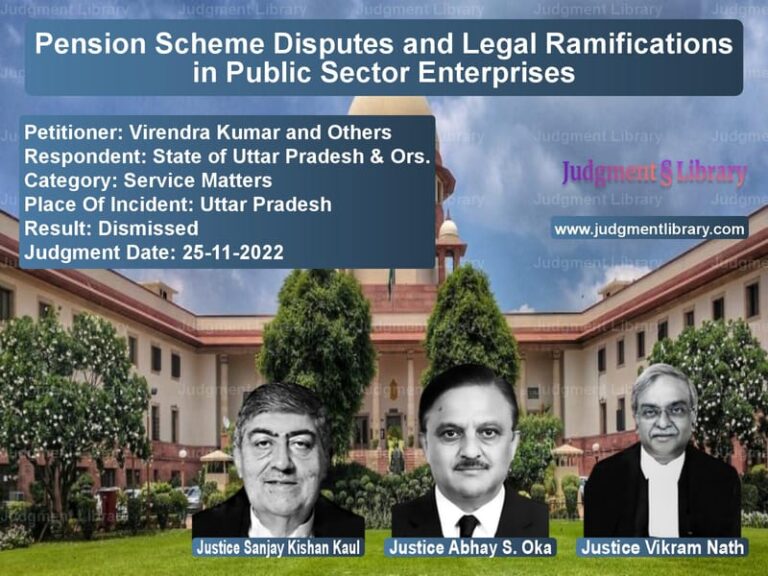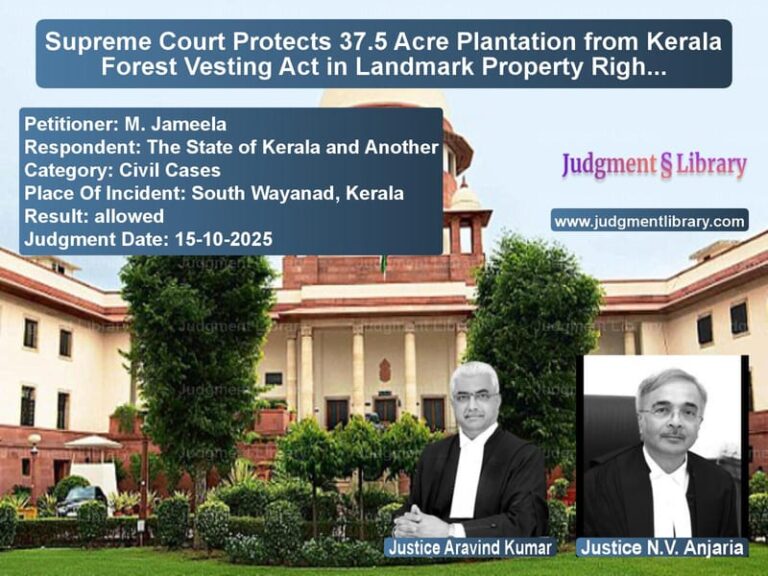Supreme Court Acquits Three in 2007 Murder Case: Critical Analysis of Circumstantial Evidence Standards
In a landmark judgment that reinforces the fundamental principles of criminal jurisprudence, the Supreme Court has acquitted three men who were convicted and sentenced to life imprisonment for the 2007 murder of a 10-year-old boy in Uttarakhand. The case, which had traveled through multiple courts over 18 years, highlights the critical importance of maintaining stringent standards when convicting accused persons based solely on circumstantial evidence.
The tragic case began on June 5, 2007, when young Muntiyaz Ali went to guard his family’s mango orchard near Kishanpur village but never returned home. His prolonged absence triggered a search by his father, Nanhe Khan, and other villagers. The next morning, the boy’s lifeless body was discovered beneath a mulberry tree near a pit on the family’s land. The scene was gruesome – a rope tightened around his neck, his hands tied behind his back with another rope, and a blood-drenched axe lying nearby.
The Initial Investigation and Trial
The father immediately lodged a written complaint at Police Station Jaspur, expressing suspicion against six co-villagers with whom he had long-standing enmity. Notably, two of the three appellants – Nazim and Aftab – were not named in this initial First Information Report. During investigation, however, Nazim and Aftab were implicated along with Arman Ali, and a chargesheet was filed against all accused persons under Sections 302 (murder), 201 (causing disappearance of evidence), 377 (unnatural offences) and 120-B (criminal conspiracy) of the Indian Penal Code.
After a full-fledged trial, the Additional Sessions Judge, Kashipur acquitted five of the accused but convicted Nazim, Aftab and Arman Ali under Sections 302, 201 and 120-B IPC, sentencing them to life imprisonment. The conviction rested largely on the testimony of three prosecution witnesses: PW-2 Tauhid Ali, who claimed to have overheard the accused conspiring to murder; PW-3 Om Prakash, presented as a ‘last seen’ witness; and PW-4 Mohammed Rafi, who claimed to have seen the appellants together on the evening of the incident.
The High Court’s Decision
The appellants challenged their conviction before the Uttarakhand High Court, which dismissed their appeals in November 2017. The High Court observed that “the Trial Court had correctly analysed the evidence on record and found no infirmity in its findings.” It affirmed that “the testimonies of PW-2, PW-3 and PW-4 were credible and that the chain of circumstances was sufficient to bring home the guilt of the Appellants.”
The High Court specifically addressed the defense arguments, noting that while PW-2 had overheard the conspiracy, “he did not take the issue very seriously, since there was enmity between the family of the accused and Nanhe Khan. He was under the impression that it was of loose talk. The statement of PW2 Tauhid Ali does inspire confidence. He has no animosity with the accused.”
Arguments Before the Supreme Court
Before the Supreme Court, the appellants’ counsel raised multiple grounds challenging the conviction. He contended that “the prosecution’s case is founded solely on circumstantial evidence and has failed to establish an unbroken chain of circumstances pointing only towards the guilt of the Appellants.” He emphasized that “several vital links necessary to establish their guilt are missing.”
The counsel particularly highlighted that “the Appellants, namely Nazim and Aftab, were not named in the FIR.” PW-1, who lodged the report, suspected six other villagers but did not mention the present appellants. “This omission in the earliest version of events raises serious doubt about subsequent attempts to implicate the present Appellants,” he argued.
Regarding PW-2’s testimony about overhearing a conspiracy, the counsel submitted that “conspiracies are not ordinarily conducted loudly in social gatherings so as to be overheard by passers-by. The claim that the accused would openly plot murder during a feast, within earshot of others seems improbable.”
On the ‘last seen’ evidence, the counsel pointed out that “PW-3 admitted in cross-examination that he did not know the Appellants earlier. Despite this, no test identification parade was conducted.” He stressed that “identification for the first time in court, without the safeguard of a prior TIP, carries little probative value and cannot be treated as reliable evidence of identity.”
The defense also challenged the forensic evidence, noting that “the FSL categorically reported that no complete DNA profile could be generated from the exhibits and, therefore, no match with the Appellants could be established.” He submitted that “both the Trial Court and the High Court ignored this crucial finding, even though it directly undercut the prosecution’s case.”
The State’s Defense
The State counsel supported the concurrent findings of the courts below, submitting that “the testimonies of PW-2, PW-3, and PW-4 are cogent, trustworthy, and mutually corroborative, and that together they establish a complete chain of circumstances pointing only to the Appellants’ guilt.”
Addressing the inconclusive DNA findings, the State counsel submitted that “failure to obtain a complete profile does not absolve the Appellants. He explained that forensic results often turn inconclusive due to the degradation of biological samples over time. Therefore, such reports cannot automatically exonerate an accused when other evidence firmly establishes guilt.”
The Supreme Court’s Analysis
The Supreme Court began its analysis by reiterating the fundamental principles governing convictions based on circumstantial evidence. Quoting from Sharad Birdhichand Sarda v. State of Maharashtra, the Court emphasized that “before a conviction can be sustained on circumstantial evidence, five conditions must be fulfilled: (i) the circumstances from which the conclusion of guilt is drawn should be fully established; (ii) the facts so established should be consistent only with the hypothesis of guilt; (iii) they should be of a conclusive nature; (iv) they should exclude every possible hypothesis except that of guilt; and (v) there must be a chain of evidence so complete that it leaves no reasonable ground for a conclusion consistent with innocence.”
The Court then applied these “five golden principles” to the present case, finding that “the evidence on record can in no fathomable circumstance complete the chain of circumstances pointing to the guilt of the accused persons. The prosecution case reveals substantial gaps.”
Regarding the omission of Nazim and Aftab from the FIR, the Court held that “the failure to name two of the three Appellants in the FIR, despite the complainant’s familiarity with them, casts a serious shadow on the subsequent attempt to implicate them. It raises a legitimate inference that their names were introduced at a later stage, thereby suggesting the possibility of false implication.”
The Court found PW-2’s testimony about overhearing the conspiracy to be “inherently improbable and lacks plausibility. Conspiracies to commit homicide are rarely, if ever, hatched so loudly and publicly as to be overheard by passers-by.” The Court noted that “this belated revelation, for the first time during the trial, bears all the hallmarks of an afterthought.”
On the ‘last seen’ evidence, the Supreme Court cited multiple precedents including State of U.P. v. Satish, where it was observed that “The last-seen theory comes into play where the time gap between the point of time when the accused and the deceased were last seen alive and when the deceased is found dead is so small that the possibility of any person other than the accused being the author of the crime becomes impossible.”
The Court found that in this case, “the interval between the alleged sightings and the discovery of the corpse is too wide to exclude the possibility of intervention by others.” PW-3 claimed to have seen the deceased with Nazim around 11:00 a.m. on June 5, 2007, while PW-4 claimed to have seen the appellants together in the evening, but the body was recovered only the next morning.
Regarding the identification evidence, the Court relied on P. Sasikumar v. State, where it was held that “In cases where an accused is a stranger to a witness and there has been no TIP, the trial court should be very cautious while accepting dock identification by such a witness.” The Court concluded that “not conducting a TIP in this case was a fatal flaw in the police investigation and in the absence of TIP the dock identification of the present appellant will always remain doubtful.”
The Final Ruling
In its conclusive findings, the Supreme Court held that “the prosecution has failed to establish a complete and unbroken chain of circumstances. The circumstances on record are not consistent with the hypothesis of the guilt of the accused and fail to exclude every other reasonable hypothesis, including their innocence. As is well-settled, suspicion, however strong, cannot take the place of proof.”
The Court accordingly allowed the appeal and acquitted Nazim, Aftab and Arman Ali of all charges. Since the appellants were on bail, their bail bonds and sureties were discharged.
This judgment serves as a powerful reminder of the fundamental principle that in criminal cases, particularly those based on circumstantial evidence, the prosecution must prove its case beyond reasonable doubt. The Court’s meticulous analysis of each piece of evidence and its insistence on the strict application of established legal principles ensures that convictions are based on solid evidence rather than suspicion or conjecture.
The decision also highlights the importance of proper investigation procedures, including conducting test identification parades when necessary and ensuring that forensic evidence is properly collected and analyzed. By setting aside the convictions, the Supreme Court has upheld the fundamental right to a fair trial and the presumption of innocence that forms the bedrock of our criminal justice system.
Petitioner Name: Nazim & Ors..Respondent Name: The State of Uttarakhand.Judgment By: Justice M.M. Sundresh, Justice Satish Chandra Sharma.Place Of Incident: Kishanpur, Uttarakhand.Judgment Date: 06-10-2025.Result: allowed.
Don’t miss out on the full details! Download the complete judgment in PDF format below and gain valuable insights instantly!
Download Judgment: nazim-&-ors.-vs-the-state-of-uttarak-supreme-court-of-india-judgment-dated-06-10-2025.pdf
Directly Download Judgment: Directly download this Judgment
See all petitions in Murder Cases
See all petitions in Judgment by M.M. Sundresh
See all petitions in Judgment by Satish Chandra Sharma
See all petitions in allowed
See all petitions in supreme court of India judgments October 2025
See all petitions in 2025 judgments
See all posts in Criminal Cases Category
See all allowed petitions in Criminal Cases Category
See all Dismissed petitions in Criminal Cases Category
See all partially allowed petitions in Criminal Cases Category







